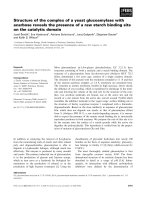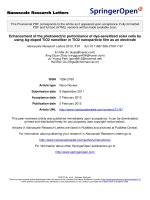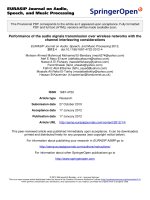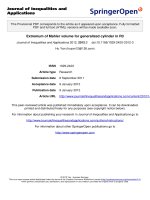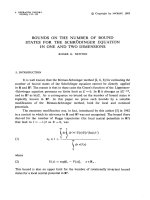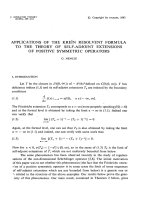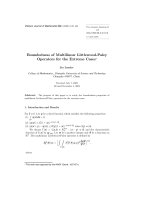Báo cáo toán học: "Zeros of the Jones polynomial are dense in the complex plane" pdf
Bạn đang xem bản rút gọn của tài liệu. Xem và tải ngay bản đầy đủ của tài liệu tại đây (179.82 KB, 10 trang )
Zeros of the Jones polynomial are
dense in the complex plane
Xian’a n Jin
∗
Fuji Zhang
School of Mathematical Sciences, Xiamen University,
Xiamen, Fujian 361005, P.R.China
Fengming Dong Eng Guan Tay
Mathematics and Mathematics Education, National Institute of Education
Nanyang Technological University, Singapore 637616, Singapore
Submitted: Apr 13, 2010; Accepted: Jun 28, 2010; Published: Jul 10, 2010
Mathematics S ubject Classification: 05C10,05C22,05C31,57M15,57M25,57M27,82B20
Abstract
In this paper, we present a formula for computing the Tutte polynomial of the
signed graph formed from a labeled graph by edge replacements in terms of the chain
polynomial of the labeled graph. Then we define a family of ‘ring of tangles’ links
and consider zeros of their Jones polynomials. By applying the formula obtained,
Beraha-Kahane-Weiss’s theorem and Sokal’s lemma, we prove that zeros of Jones
polynomials of (pretzel) links are dense in the whole complex plane.
1 Introduction
Let L be an oriented link, and D be a diagram of L. Let V
L
(t) be the Jones polynomial
[1] of L. The writhe w(D) of D is defined to be t he sum of signs of the crossings of L. Let
[D] be the one-variable Kauffman bracket polynomial [2] of D in A (with the orientation
of D coming from L ignored). Let
f
L
(A) = (−A
3
)
−w(D)
[D].
Then [2]
V
L
(t) = f
L
(t
−1/4
).
∗
Corresponding author.
the electronic journal of combinatorics 17 (2010), #R94 1
It is well known that there is a one-to-one correspondence between link diagrams and
signed plane graphs via the medial construction [3]. Based on this correspondence, in [3]
Kauffman converted the Kauffman bracket polynomial to the Tutte polynomial of signed
graphs, which are not necessarily planar. Let G be a signed graph. We shall denote by
Q[G] = Q[G](A, B, d) ∈ Z[A, B, d] the Tutte polynomial of G. To analyze zeros of Jones
polynomials, it suffices for us to consider the Tutte polynomials of signed gr aphs.
There have been some works on zeros of Jones polynomials [4 ]- [9]. For example, the
distribution of zeros of Jones polynomials for prime knots with small crossing number has
been depicted in [4] and [5]. See Fig. 1 for an example. Looking at these figures, one
may be tempted to conclude that zeros of Jones polynomials do not exist in some regions,
for example, a small circle region around z = 1 and a large area in the left half complex
plane. But in this paper by considering zeros of pretzel links we shall show that, on the
contrary, zeros of Jones po lynomial of knots are dense in the whole complex plane. We
point out that Sokal proved that chromatic roots a r e dense in the whole complex plane
[10], and Zhang and Chen proved eigenvalues of digraphs are dense in the whole complex
plane [11].
Fig. 1: Zeros of 1288 prime alternating knots with crossing number 12 [4].
This paper contains two parts. The first part is on a formula of computing the Tutte
polynomial of signed graphs formed by edge replacements via the chain polynomial [12].
This result generalizes our previous results in [13]. It is worth noting that there are two
closely related results in [14] and [15]. In the second part, we consider the Tutte polynomial
of ‘ring of tangles’ links which include the well known pretzel links. By applying Beraha-
Kahane-Weiss’s Theorem and Sokal’s lemma, we prove that zeros of the Jones polynomial
of pretzel knots are dense in the complex plane.
the electronic journal of combinatorics 17 (2010), #R94 2
2 Tutte polynomials of signed graphs formed by edge replace-
ments
The chain polynomial was introduced by Read and Whitehead in [12] for studying
the chromatic polynomials of homeomorphic graphs. It is defined on labeled graphs, i.e.
graphs whose edges have been labeled with elements of a commutative ring with unity.
Although in a labeled graph different edges can receive the same label, we usually denote
the edges by the labels associated with them. Th e chain polynomial Ch[G] of a labeled
graph G is d efined as
Ch[G] =
Y ⊂E
F
G−Y
(1 − w)
a∈Y
a (1)
where the sum is over all subse ts of the edge set E of G, F
G−Y
(1 − w) denotes the flow
polynomial in q = 1 − w of G − Y , the graph obtained from G by deleting the edges in Y ,
and
a∈Y
a denotes the product of labels in Y .
The following lemma was given implicitly in [12] and explicitly in [15]. It can be
viewed as an alternative definition of the chain polynomial.
Lemma 2.1 The chain polynomial satisfies the following recursive rules:
(1) If G is edgeless, then
Ch[G] = 1. (2)
(2) Otherwise, s uppose a is an edge of G, we have:
(a) If a is a loop, then
Ch[G] = (a − w)Ch[G − a]. (3)
(b) If a is not a l oop, then
Ch[G] = (a − 1)Ch[G − a] + Ch[G/a]. (4)
Example 2.2 (1) Let Θ
p
be the l abeled graph consisting of two vertices connected by p
parallel edges a
1
, a
2
, · · · , a
p
. Then [7]
Ch[Θ
p
] =
1
1 − w
p
i=1
(a
i
− w) − w
p
i=1
(a
i
− 1)
. (5)
(2) Let B
p
be a labeled “bouquet of p circles”, i.e. a labeled graph with one vertex and p
loops a
1
, a
2
, · · · , a
p
. By Lemma 2.1, we obtain
Ch[B
p
] =
p
i=1
(a
i
− w). (6)
the electronic journal of combinatorics 17 (2010), #R94 3
Definition 2.3 Let G be a connected labeled graph. We define
ˆ
G to be the signed graph
obtained f rom G by replacing each edge a = uw of G by a connected signed graph H
a
with
two a ttached v ertices u and w that has o nly the vertices u and w in common with
G − a.
Now we shall establish a relation between the Tutte polynomial of
ˆ
G and the chain
polynomial of G. The following two splitting lemmas on Tutte polynomials of signed
graphs will be used in proving Theorem 2.6.
Lemma 2.4 [3]
(1) Let G
1
∪ G
2
be the disjoint union of two s i g ned graphs G
1
and G
2
. Then
Q[G
1
∪ G
2
] = dQ[G
1
]Q[G
2
]. (7)
(2) Let G
1
· G
2
be the union of two signed graphs G
1
and G
2
having onl y one common
vertex. Then
Q[G
1
· G
2
] = Q[G
1
]Q[G
2
]. (8)
Lemma 2.5 [16] Let G be the union of two signed graphs G
1
and G
2
having only two
common vertices u
1
and u
2
. Let H
1
and H
2
be si gned graphs obtained from G
1
and G
2
,
respectively, by i dentifying u
1
and u
2
. Then
Q[G] =
1
d
2
− 1
{dQ[H
1
]Q[H
2
] + dQ[G
1
]Q[G
2
] − Q[H
1
]Q[G
2
] − Q[G
1
]Q[H
2
]}. (9)
Let H
′
a
be the graph obtained from H
a
by identifying u and w , the two attached
vertices of H
a
. Let
α
a
= α[H
a
] =
1
d
2
− 1
(dQ[H
a
] − Q[H
′
a
]), (10)
β
a
= β[H
a
] =
1
d
2
− 1
(dQ[H
′
a
] − Q[H
a
]), (11)
γ
a
= γ[H
a
] = 1 + d
α[H
a
]
β[H
a
]
(12)
Theorem 2.6 Let G be a connected labeled graph, and
ˆ
G be the signed graph obtained
from G b y rep l acing the edge a by a connected signed graph H
a
for every edge a in G. If
we replace w by 1 − d
2
, and replace a by γ
a
for every label a in Ch(G), then we ha ve
Q[
ˆ
G] =
a∈E(G)
β
a
d
q(G)−p(G)+1
Ch[G], (13)
where p(G) and q(G) are the numbers of vertices and edges of G, respectively.
the electronic journal of combinatorics 17 (2010), #R94 4
Proof. By solving Eqs. (10) and ( 11), we obtain
Q[H
′
a
] = α
a
+ dβ
a
. (14)
When the edge a is a loop of G, by Lemma 2.4 (2) and Eq. (14), we have
Q[
ˆ
G] = Q[H
′
a
]Q[
G − a]
= (α
a
+ dβ
a
)Q[
G − a]. (15)
When the edge a is not a loop, by Lemma 2.5, we have
Q[
ˆ
G] =
1
d
2
− 1
{dQ[
G/a]Q[H
′
a
] + dQ[
G − a]Q[H
a
] − Q[
G/a]Q[H
a
] − Q[H
′
a
]Q[
G − a]}
=
1
d
2
− 1
{Q[
G − a](dQ[H
a
] − Q[H
′
a
]) + Q[
G/a](dQ[H
′
a
] − Q[H
a
])}
= α
a
Q[
G − a] + β
a
Q[
G/a]. (16)
Now let
T [G] =
d
q(G)−p(G)+1
a∈E(G)
β
a
Q[
ˆ
G].
If G is an edgeless graph with n vertices, then
T [E
n
] = d
−n+1
d
n−1
= 1. (17)
Otherwise, suppose that a is an edge of G.
(1) If a is a loop of G, by Eq. (15), we have
T [G] =
d
q(G)−p(G)+1
b∈E(G)
β
b
(α
a
+ dβ
a
)Q[
G − a]
=
d
q(G−a)+1−p(G−a)+1
β
a
b∈E(G−a)
β
b
(α
a
+ dβ
a
)Q[
G − a]
= d(d +
α
a
β
a
)T [G − a]. (18)
(2) If a is not a loop, by Eq. (16), we have
T [G] =
d
q(G)−p(G)+1
b∈E(G)
β
b
Q[
ˆ
G]
=
d
q(G)−p(G)+1
b∈E(G)
β
b
(α
a
Q[
G − a] + β
a
Q[
G/a])
=
d
q(G−a)+1−p(G−a)+1
β
a
b∈E(G−a)
β
b
α
a
Q[
G − a] +
d
q(G/a)+1−p(G/a)−1+1
β
a
b∈E(G−a)
β
b
β
a
Q[
G/a]
= d
α
a
β
a
T [G − a] + T [G/a]. (19)
the electronic journal of combinatorics 17 (2010), #R94 5
Comparing the coefficients of Eqs. (17)-(19) with those of (2)-(4) in Lemma 2.1, we know
that T [G] = Ch[G] |
w=1−d
2
,a=γ
a
. Theorem 2 .6 follows directly.
Hereafter, we always suppose that B = A
−1
, d = −A
2
−A
−2
. Let X = A+Bd = −A
−3
.
Let H
a
= P
+
n
, a positive path with length n. Then Q[P
+
n
] = X
n
. It is not difficult to
obtain
Q[C
+
n
] = (X
n
− A
n
)/d + dA
n
.
Thus,
α[P
+
n
] = (X
n
− A
n
)/d,
β[P
+
n
] = A
n
,
γ[P
+
n
] = (X/A)
n
= (−A
−4
)
n
.
Hence, we have
Corollary 2.7 [13] Let G be a co nnected labeled graph. Let G
c
be the signed graph ob-
tained from G by replacing each edge a by a positive path with length n
a
. In Ch[G], if we
replace w by 1 − d
2
, and replace a by (−A
−4
)
n
a
for every label a, then we have
Q[G
c
] =
A
P
a∈E(G)
n
a
d
q(G)−p(G)+1
Ch[G], (20)
where p(G) and q(G) are the numbers of vertices and edges of G, respectively.
Example 2.8 (1) The generalized theta graph Θ
s
1
,···,s
p
consists of end-vertices x, y con-
nected by p internally disjoi nt positive paths o f lengths s
1
, · · · , s
p
. By Eq. (5) and
Corollary 2.7, w e ob tain
Q[Θ
s
1
,···,s
p
] =
A
P
s
i
d
p+1
p
i=1
((−A
−4
)
s
i
+ d
2
− 1) + (d
2
− 1)
p
i=1
((−A
−4
)
s
i
− 1)
. (21)
Note that the formula is essentially the sam e as the formula for Kaufman bracket
polynomial of pretzel l i nks in [17].
(2) Let B
s
1
,···,s
p
be the graph consisting of one vertex incid ent with p internally d i s j oint
positive cycles of leng ths s
1
, · · · , s
p
. By Eq. (6) and Corollary 2.7, we obtain
Q[B
s
1
,···,s
p
] =
A
P
s
i
d
p
p
i=1
((−A
−4
)
s
i
+ d
2
− 1). (22)
By Example 2.8, we obtain
α[Θ
s
1
,···,s
p
] =
A
P
s
i
d
p
p
i=1
((−A
−4
)
s
i
− 1), (23)
β[Θ
s
1
,···,s
p
] =
A
P
s
i
d
p+1
p
i=1
((−A
−4
)
s
i
+ d
2
− 1) −
p
i=1
((−A
−4
)
s
i
− 1)
. (24)
the electronic journal of combinatorics 17 (2010), #R94 6
3 Zeros of Jones polynomials are dense in the whole
complex plane
Suppose that {f
n
(x)|n = 1, 2, · · ·} is a family of polynomials. A complex number z is
said to be the limit of zeros of {f
n
(x)} if either f
n
(z) = 0 for all sufficiently large n or z
is a limit point of the set ℜ({f
n
(x)}), where ℜ({f
n
(x)}) is the union of the zeros of the
f
n
(x)
′
s. In [18], Beraha, Kahane and Weiss proved the following theorem.
Theorem 3.1 If {f
n
(x)} is a family of polynomials such that
f
n
(x) = α
1
(x)λ
1
(x)
n
+ α
2
(x)λ
2
(x)
n
+ · · · + α
l
(x)λ
l
(x)
n
, (25)
where the α
i
(x) and λ
i
(x) are fixed non -zero polynomials, such that no pair i = j has
λ
i
(x) ≡ ωλ
j
(x) for some complex number ω of unit modulus, then z is a limit of zeros of
{f
n
(x)} if and only if
(1) two or more of the λ
i
(z) are of equal modulus, and strictly greater in modulus than
the others; or
(2) for some j, the modulus of λ
j
(z) is strictly greater than those of the others, and
α
j
(z) = 0.
Now we define a family of ‘ring of ta ngles’ links. Let H
i
be a signed plane graph
and u
i
, v
i
be two distinct vertices of H
i
lying in the boundary of the unbounded face for
i = 1, 2, · · ·, n. Let C(H
1
, H
2
, · · · , H
n
) be the signed plane graph o bta ined by identifying
u
i
with v
i+1
for each i = 1, 2, · · · , n − 1, and identifying u
n
with v
1
. We denote by
L(T
1
, T
2
, · · · , T
n
) the link diagram corresponding to C(H
1
, H
2
, · · · , H
n
) with the tangle T
i
corresponding to H
i
for i = 1, 2, · · ·, n, and call it a ‘ring of tangles’ link. In particular, if
H
1
= H
2
= · · · = H
n
= H, we denote C(H
1
, H
2
, · · · , H
n
) by C
n
(H) for simplicity.
Lemma 3.2 Let L
n
(T ) be the link diag ram corresponding to C
n
(H) with the tan g l e T
corresponding to the signed plane graph H. Let Q(H) = Q[H]|
A=t
−1/4
and β(H) =
β[H]|
A=t
−1/4
. Then points sa tisfying the following equation
|β(H)| = |Q(H)| (26)
are limits of z eros of Jones polynomials of {L
n
(T )|n = 1, 2, · · ·}.
Proof.
(1) Let C
n
be the n- cycle, and its edges are all lab eled with a. By using the definition of
the chain polynomial, it is not difficult for us to obtain Ch[C
n
] = a
n
− w. Replacing
a suitably by the signed plane graph H, we obtain C
n
(H). By Theorem 2.6, we
have
Q[C
n
(H)] =
β[H]
n
d
(γ[H
i
]
n
− (1 − d
2
))
=
d
2
− 1
d
β[H]
n
+
1
d
(β[H] + dα[H])
n
=
d
2
− 1
d
β[H]
n
+
1
d
Q[H]
n
.
the electronic journal of combinatorics 17 (2010), #R94 7
(2) By replacing A by t
−1/4
, we obtain
V
L
n
(T )
(t)
.
=
1
t + 1
{(t
2
+ t + 1)β(H)
n
+ tQ(H)
n
}, (27)
where
.
= denotes equality up to a factor ±t
k/2
. Then by applying Beraha-Kahane-
Weiss’s Theorem, we obtain the lemma.
The following Sokal’s lemma [10] will play an important role in proving our main
result.
Lemma 3.3 Let F
1
, F
2
, G be analytic functions on a disc |z| < R s atisfying |G(0)| 1
and G not co nstant. Then, for each ǫ > 0, there exists s
0
< ∞ such that for all integers
s s
0
the equation
|1 + F
1
(z)G(z)
s
| = |1 + F
2
(z)G(z)
s
| (28)
has a solution in the disc |z| < ǫ.
Lemma 3.4 Let t
0
be any complex number. For any real ǫ > 0, there is a signed plane
graph H s uch that Eq. (26) has a zero t with |t − t
0
| < ǫ.
Proof. Let I
s
be the graph with two vertices x and y, and s parallel edges joining x and y.
Denote by I
+
s
and I
−
s
the two signed graphs obtained from I
s
by assigning its each edge a
positive sign and a negative sign, respectively. By setting p = s and s
1
= s
2
= · · · = s
p
= 1
in Eqs. (23) and (24), we obtain
α[I
+
s
] = A
−s
,
β[I
+
s
] =
(−A
3
)
s
− A
−s
−A
2
− A
−2
.
Thus we have
Q[I
+
s
] = β[I
+
s
] + dα[I
+
s
] =
1
−A
2
− A
−2
(A
4
+ A
−4
+ 1)A
−s
+ (−A
3
)
s
.
Then the equation
|β[I
+
s
]| = |Q[I
+
s
]|
is equiva lent to
|1 + (−1)
s−1
A
−4s
| = |1 + (−1)
s
(A
4
+ A
−4
+ 1)A
−4s
|.
Letting A = t
−1/4
, this equation is transformed into
|1 − (−t)
s
| = |1 + (t + t
−1
+ 1)(−t)
s
|. (29)
the electronic journal of combinatorics 17 (2010), #R94 8
Let t
0
be an any fixed complex number with |t
0
| 1 and t
0
= 0. Setting z = t − t
0
,
Eq. (29) becomes
|1 − (−z − t
0
)
s
| = |1 + (z + t
0
+ (z + t
0
)
−1
+ 1)(−z − t
0
)
s
|. (30)
By Sokal’s Lemma (F
1
(z) = −1, F
2
(z) = (z + t
0
+ (z + t
0
)
−1
+ 1), G(z) = (−z − t
0
)),
then for any ǫ > 0, there exists s
0
such that for any s s
0
, Eq. (30) has a zero z satisfying
|z| < ǫ, i.e. Eq. (29) has a zero t = z + t
0
satisfying |t − t
0
| < ǫ.
For the special case that t
0
= 0, by the above result, there exists s
0
such that for any
s s
0
, Eq. (29) has a zero t satisfying |t − ǫ/2| < ǫ/2, implying that |t| < ǫ.
Now consider I
−
s
, in this case, Eq. (29 ) becomes
|1 − (−t
−1
)
s
| = |1 + (t + t
−1
+ 1)(−t
−1
)
s
|. (31)
If |t
0
| 1, by Sokal’s Lemma, for any ǫ > 0 ,there exists s
0
such that for any s s
0
,
Eq. (31) has a zero t satisfying | t − t
0
| < ǫ.
Theorem 3.5 Zeros of Jo nes polynomials are dense in the whole complex plane.
Proof. Let t
0
be any complex number and ǫ any positive real number. By Lemma 3.4 ,
there exists a signed plane gr aph H such t hat Eq. (26) has a zero t
′
with |t
′
− t
0
| < ǫ/2.
Then, by Lemma 3.2, there exists a n integer n > 0 such that V
L
n
(T )
(t) has a zero t with
|t − t
′
| < ǫ/2. Together, these mean that there exists a zero t of some Jones polynomial
with |t − t
0
| < ǫ.
Finally, we give two remarks on Theorem 3.5.
1. Note that C
n
(I
+
s
) and C
n
(I
−
s
) correspond to the pretzel link P (
n
s, s, . . . , s) with
s > 0 and s < 0. We actually prove that the zeros of Jones polynomials of pretzel
links are dense in the whole complex plane.
2. Using Beraha-Kahane-Weiss’s Theorem we can also prove that points of Eq. (26)
are also limits o f zeros of Jones polynomials of the link subfamily {L
2k+1
(T )|k =
1, 2, · · ·}. Note that when n and s are both odd numbers, P (
n
s, s, . . . , s) is a knot.
Hence, we can further prove that zeros of Jones po lynomial of such pretzel knots
are dense in the whole complex plane.
Acknowledgements This paper was partially finished during Xian’an Jin’s visit at t he
National Institute of Education, Singapore, supported by NIE AcRf Funding (R1 5/0 6
DFM). Xian’an Jin and Fuji Zhang are also partially supported by NSFC Grant No.
10831001.
the electronic journal of combinatorics 17 (2010), #R94 9
References
[1] V.F.R. Jones, A polynomial invariant for knots via Von Neumann a lg ebras, Bull.
Am. Math. Soc. 12 (1985) 103-112.
[2] L.H. Kauffman, State models and the Jones polynomial, Topology 26 (1987) 395-407 .
[3] L.H. Kauffman, A Tutte polynomial for signed graphs, Discrete Appl. Math. 25
(1989) 105-127.
[4] X S. Lin, Zeros of the Jones polynomial, xl/abs-jk.pdf.
[5] F.Y. Wu, J. Wang, Zeros of the Jones polynomial, Physica A 296 (2001) 483-494.
[6] S C. Chang, R. Shrock, Zeros of Jones polynomials for families o f knots and links,
Physica A 301 (200 1) 196-218.
[7] X. Jin, F. Zhang, Zeros of the Jones p olynomials for families of pretzel links, Physica
A 328 (2003) 391-408 .
[8] A. Champanerkar, L. Kofman, On the Mahler measure of Jones polynomials under
twisting, Algebr. Geom. Topol. 5 (2005) 1-22.
[9] S. Ja blan, L. Radovic, R. Sazdanovic, Tutte and Jones polynomial of link families,
Advanced School and Conference on Knot Theory and its Applications to Physics
and Biology, May 11-29, 2009 International Centre for Theoretical Physics Trieste,
Italy. />[10] A.D. Sokal, Chromatic roots are dense in the whole complex plane, Comb. Probab.
Comput. 13 (2004) 221-261.
[11] F. Zhang and Z. Chen, Limit points of eigenvalues of (di)graphs, Czech. Math. J. 56
(2006) 895-902.
[12] R.C. Read, E.G. Whitehead Jr., Chromatic polynomials of homeomorphism classes
of graphs, Discrete. Math. 204 (19 99) 337-356.
[13] X. Jin, F. Zhang, The Kauffman brackets for equivalence classes of links, Adv. in
Appl. Math. 34 (2005) 47-6 4.
[14] D.R. Woodall, Tutte polynomial expansions for 2-separable graphs, Discrete Math.
247 (2002) 201-21 3.
[15] L. Traldi, Chain polynomials and Tutte polynomials, Discrete Math. 248 (2002) 279-
282.
[16] X. Jin, F. Zhang, On computing Kauffman bracket polynomial of Montesinos links,
J. Knot Theory Ramifications, accepted.
[17] P.M.G. Manch´on, On the Kauffman bracket of pretzel links, Marie Curie Fellowships
Annals, Second Volume, 2002.
/>[18] S. Beraha, J. Kahane, N.J. Weiss, Limits of zeros of recursively defined families of
polynomials, Studies in Foundations and Combinatorics, Advances in Mathematics
Supplementary Studies, 1 (1978) 212-232.
the electronic journal of combinatorics 17 (2010), #R94 10
